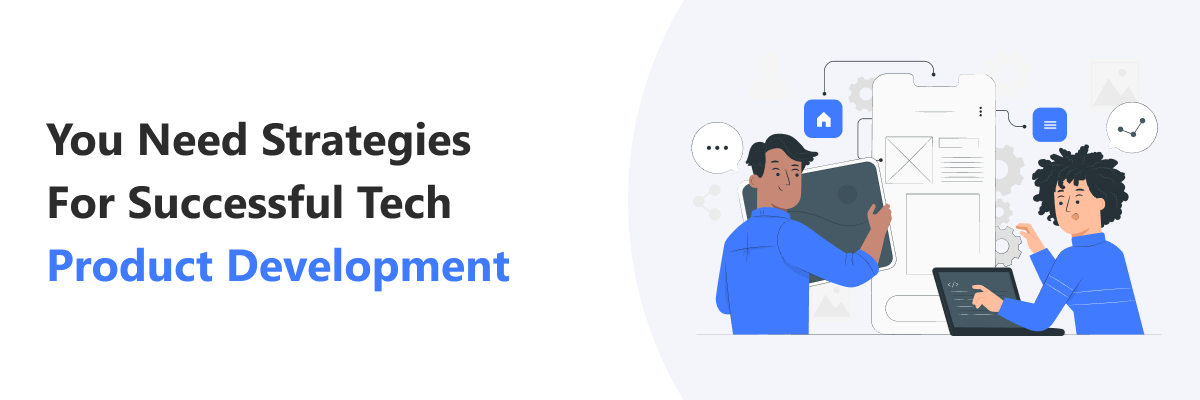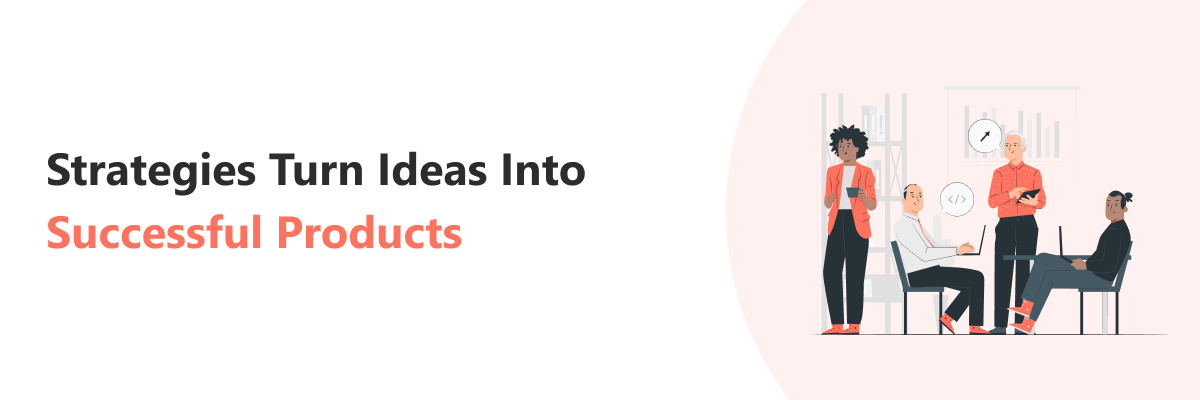To you, what’s the best part of playing chess?
Don’t worry, you’re reading the right blog! We’ll get to the product development strategy part in a bit, but first, think of this scenario.
If you don’t play chess, think of any game that requires more than luck to win! Now, in order to win, it’s important _how_ you play the game!
Simply put,you strategise to win.
You analyse my opponent’s playing style, anticipate his or her moves, and plan ahead to make sure that you’re always two steps ahead of the game.
This might not always ensure a smooth victory, but it does help you ensure that I leave little to no room for error. No matter the outcomes, you will have done my part to ensure I walk away victorious.
Are Strategies Only for Games?

No, they are not. They apply to the business world too. And, that is exactly what you need to do before you start worrying about how you start the different phases of your tech product development process – strategise.
You must plan ahead and leave no room for error. In order to make calculated moves for your product development process, you need to consider multiple variables affecting different stages of your product development.
Build a solid plan that mitigates risks as much as possible and ensures smooth sailing : that is what product development strategy is all about.
In this blog, we’ll examine some important topics which will cover concepts such as:
-
-
- What is product development strategy
- The importance of having a product development strategy for your tech product development
- Types of product development strategies
- The methodology you can use to create a watertight product development strategy for your business.
-
What is a Product Development Strategy?

Product development strategy, a subset of corporate strategy, is a clear plan of actions that is curated to help you achieve product success, and ultimately organisational success.
If you have a good product development strategy in place, you can rest assured of three primary goals:
-
-
- Innovate and create sustained product success
- Get ahead of the competition in your market
- And ensure delightful experiences for your customers.
-
In a nutshell, a product development strategy gives your venture a good direction to work towards, as opposed to playing it by ear and stumbling in the dark. It helps you establish clear and defined goals, set realistic deadlines for your milestones, and make informed business decisions to give you a competitive edge.
So, if you ask ‘what is product development strategy?’, a simple answer would be – it is the key to unlocking the success of your final product in its intended market.
Apple, Amazon, Microsoft, Netflix, and Google are some industry giants who have utilised the power of product development strategies to establish themselves in the market of their choice.
Is It Necessary to Invest Time in a Product Development Strategy?

Is it necessary to plan in a game of chess?
Of course, you can say no, but how often do your defensive strategies yield fruit if you cannot predict your opponents’ moves? Without a strategy, you expose yourself to risky moves and leave your victory at the mercy of luck.
Trust us, you do not want to go in blind to your product development. There is a lot at stake that you cannot simply leave to luck. Your investors and your team count on you to make your new product ideas a successful reality!
Product development strategies help you position your product in the market in a way that is irresistible to your consumers, highlight why your products are better than that of your competitors, and paves the way for new product growth. It can help you improve your sales growth and ultimately bring in more revenue and profits.
But that’s not all!
Here’s what you can do with a well-planned product strategy:
-
-
- You will have to conduct thorough market research to establish a product development strategy, which means you will know your target markets like the back of your hand.
- You will be able to implement stringent product screening guidelines to validate your product idea before you start the product development process.
- You can have a clearly outlined product roadmap to guide you and your product team towards your ultimate goal.
- You will be able to roll out successful products continuously and enhance your product portfolio.
- You will have plenty of room for creativity and innovation in your product development if you incorporate innovative product modification strategies.
- Each phase in the life cycle of your product development process will be clearly mapped out, leaving no room for omission or error.
- Your product managers and your development team will be able to avoid bottlenecks caused by a lack of clarity of direction and can perform at their productive best.
- You will be able to identify exciting opportunities for new product lines in the existing market and create new products as business verticals.
- You will be able to make informed business and funding decisions, thus mitigating the common risks associated with startup product development.
-
It is safe to say that it takes more than just a great team and solid funding – you need a clear vision and a strategy that supports your vision to create a successful product.
Now that the long-term importance of implementing a product development strategy is clear. Let us look at how streamlined strategies have helped successful industry moguls like Apple, Microsoft, Google, and more drive their business growth.
A Closer Look at the Different Types of Product Development Strategies

Types of product development strategies can be broadly classified into four, based on how you decide to approach your strategy creation process:
1. Time-Based Approach
The time-based approach is one way of tackling a product development strategy. In this method, you emphasise when your product is launched.
If this is the type of strategy you are going for, then make sure you are ahead of your competition by either being the first to enter your market or being a quick study who follows shortly and gives the ‘first-to-market’ some serious competition!
According to research, the first to the market will tend to hold the cards because you will already have established yourself among an audience and familiarise them with your offerings.
If you want to follow the market leader, you will have to make sure that your product has some unique selling points that are much more desirable than that of your competition.
2. Market-Oriented Approach
If you are more focused on getting a foothold in the market and breaking even quickly, you need to consider a market-oriented approach when you devise your product development strategy.
In this way of approaching a product development strategy, you need to analyse your market thoroughly to get an idea of the opportunities present in your niche.
If you understand what is lacking in the market of your choice, you will be able to come up with the right solutions to bridge the gap between the needs of your target audience and the scarcity in your current market.
Make sure you take a look at the types of research methodologies you can employ to get the best data for your product development strategy.
3. Platform-Based Approach
If you already have a platform to build your products on, then a platform-based approach might be the best way to curate your product development strategy.
The first thing you need to do is analyse the strengths, weaknesses, and potential capabilities of your platform.
You can then explore different tangents in which you can grow your verticals using the strengths of your base platform. Apple is a great example of a corporate giant that used the platform-based approach to push more exceptional products into the market.
4. Customer-Oriented Approach
Are you familiar with the concept of design thinking?
Simply put, design thinking is the process of solving business pain points by giving priority to the consumer’s needs above all other needs. Design thinking requires good observational skills so that you can understand your customers and empathise with them.
If you get a clear picture of how your consumers interact with their surroundings, you can deploy solutions that are in sync with their needs through an iterative, hands-on approach.
Design thinking is the key element of a customer-oriented approach for developing a product market strategy.
In this approach, you will tailor your product development strategies in accordance with the needs of your end users. You can do this by implementing a series of continuous feedback loops and keeping in touch with the expectations of your consumers.
This is one of the most successful approaches you can take to product development strategy for a simple reason: at the end of the day, your product is supposed to solve your consumer’s problems and they know best about what they need.
Developing a Product Development Strategy – How to Get Started

Developing a product development strategy is all about planning. The basic aspects you need to keep ready before you get started are:
-
-
- A clear vision that your team can follow in unity.
- A Plan-A and a contingency plan, just in case!
- Roadmaps that will guide you to your ultimate goal.
-
How to Create a Demographic-Specific Product Development Strategy?
1. Identify the Differentiating Characteristics of Your Niche Demographic
By definition, a demographic is a certain section of a population – a population subset, if you will!
So, what is your demographic?
Start by trying to answer this simple question and we can assure you that the intensive and extensive research you do to figure out the answer will give you a clear idea of your target audience.
-
-
- What is the audience you are targeting?
- How are they different from other demographics in the market?
- What sets them apart?
-
You will need to set up a dedicated team to nitpick through the collected data to identify the distinguishing features that set your demographic apart. This is a good way to try to curate a product development strategy that is customised to their unique needs.
And, once you have your target audience in place, you’ll be able to understand the user predilections and expectations which will form the foundation for your product development strategy.
2. Understand Your Target Audience’s Pain Points
Now, it’s time to walk a few miles in your end user’s shoes!
-
-
- What are the problems they face?
- What are the solutions that can make their life easier?
- How can you make sure that you meet your user expectations with your final product?
-
To get your business to grow, you need to have a good business plan, as well as a convincing investor pitch. You need financial projections and budgetary restrictions. But, that’s not all.
You also need to come up with a prototype or a Minimum viable Product (MVP) that you can use for your soft launch or test marketing. This will give you an idea of what drives your end users in terms of functionality.
3. Analyse All the External Factors Influencing Your Audience
Here’s another question you need to consider: what are the external cues that determine the purchase decisions of your user demographic?
-
-
- If you were part of that demographic, would you buy the product you have to offer?
- How are the users in your demographic positioned?
- What are the logistics you will need to consider in order to cater to your audience without any hiccups?
-
Once you have clear answers to these questions, you can start centering your product development process around the needs of your demographic, as well as your ability to meet those needs in a practical way.
4. Explore Similar Demographics for Connections
Your business model will not be sustainable if you get complacent and leave no room for innovation.
Make sure you have an active team working on your competitor analysis so that you can keep improving your unique selling points and stay relevant in what might become a saturated market.
Also Read: How to Create a Unique Selling Proposition That Boosts Your Business
If your tech product has a good platform to back it up, you can start creating growth strategies to expand your services to similar demographics and similar markets.
It is important to get a clear picture of the realities of tech product development so that you can curate a product development strategy that is aligned with the best interests of all your stakeholders.
Ensuring the Success of Your Demographic-Specific Product Development Strategy

Now that you have the know-how for creating a demographic-specific product development strategy for your tech product development. Next, you need to make sure that you vet, validate, and execute it well.
To successfully implement a holistic product development strategy that will benefit your business now and in the future, it would be a good idea to keep the following tips in mind:
1. Innovate Beyond Your Core Offering
Your primary focus should always be on your core product, of course. But, once you have the development strategy in place to hone your core product to its best sheen, you can start planning the next step – innovation.
At the end of the day, it is all about your end users. Without them, your product will become obsolete. So, consider how you can innovate and evolve beyond your core product to achieve customer satisfaction.
Consider what sort of ancillary benefits you can conjure up to enhance the customer experience you want to provide while delivering your core product.
For example, FedEx and UPS were competitors until FedEx came up with a new innovation designed to meet a user pain point – package tracking. Then, FedEx took over because everyone wanted the ancillary capability they offered because it made their wait for packages much more tolerable!
Simply put, you can monopolise markets with more than your core products. And once you perfect your customer experience with enhanced capabilities, you can dominate!
2. Take a Step Back and Look at the Bigger Picture
It is easy to become too focused on just your core products and lose track of the bigger picture. What if your core product can do more than the functionalities you designed it for?
Of course, your core product needs to stand on its own two feet before you can make it run and conquer the business world. But, once it’s steady, do not stop yourself from looking at new opportunities to expand and new markets to take on.
You can try to find new applications for your product in the same market or new ones. For example, an e-commerce development platform can be tweaked to cater to the needs of an online real estate business. They both have product pages and similar user flows, but will let you take over two separate markets in one go!
Two markets, one core base product, if you will!
3. Connect Your Vision, Product Strategy, and Budget
First, you need to be a man (or woman) with a plan! Make sure you have a clear idea of your corporate vision and tie it to your product development strategy.
Ask yourself these questions:
-
-
- What is your short-term goal?
- What is your long term mission?
- What is the vision you have for your business?
- What are feasible timelines you can set for your missions and your vision?
- When does your final product have to hit the market for your vision to become a reality?
- And, the big one: do you have the funds to make it all happen?
-
Once you set practical milestones for your product development and launch with your vision in mind, connect everything to the benevolence of your investors, that is, with the funds you have in your business account!
Your corporate vision, product development strategy, the resources and technologies you plan on using, your timelines, and your budget should all be in sync with one another. A clear roadmap to success will aid you in the perfect execution of your product development strategy.
4. Nurture Your Team to Break Boundaries
Your team is your strongest asset, if you choose your team members carefully and train them the right way, they can take your tech products to heights you might not even imagine!
It is not easy to augment a product portfolio without the right team and the right attitude. With the right governance and a robust Research and Development wing, your team will be able to push boundaries and innovate better.
You need to implement a process of continuous learning as part of your product development strategy and make sure that your team is empowered to not only meet their goals, but also work unitedly towards a common vision.
When you think about it, your team is only as strong as its weakest member, so put in the effort to make sure that each member of your team is not only skilled, but also passionate in what they do and follow a process of continuous learning.
5. Make Sure Your Tech Development is Process-Driven
First things first, what does it mean when we say something is process-driven?
In a process-driven system, things are organised and carried out in a procedural way.
For example, let’s say a task has 3 steps – A, B, and C – that you need to complete in that particular sequence for the task output to be optimised. You can either carry out the steps haphazardly – A, C, and then B – or do it the organised way – A, B, and C, as prescribed.
While there will be definite results in both cases, the measurable output will vary for both. The task that was carried out as recommended – A, B, and then C – will likely show a more productive output. This is a process-driven way of completing the task – B cannot come before A and C is the final step. A product development process that works in a process-driven manner is more likely to succeed within the stipulated timelines.
It will ensure that your product development team is focused and works efficiently in an organised way. Your pipeline will be well thought out and streamlined for the best results.
Also, when you carry out your processes in a systematic way, you are less likely to miss any important steps or get lost in the clutter of numerous tasks.
Conclusion

Developing a product is not easy.
Cliched as these words are, there are no shortcuts to success – especially when it comes to tech product development strategies, because the variables are immense.
You need the right team. You need to figure out the optimal audience for your offerings. You need reliable inventors to back you up. You need to consider the market conditions.
In today’s world, the socio-political fabric underlying all major global businesses can also be a formidable variable that you need to consider!
In fact, if you want to map out a demographic-specific product strategy for multiple demographics, you will really have to do your research on how different demographics of your audience function independently and also when interacting with each other.
But, it can be done with a little bit of persistence and a lot of planning. So, structure out your business plan and keep in mind the tips we compiled for you before you start creating your custom product development strategy!
Tech product development is not easy, but if done well, it can ensure optimal results for your final product.
We can help you get it done! Get in touch with one of NeoITO’s experts today!




